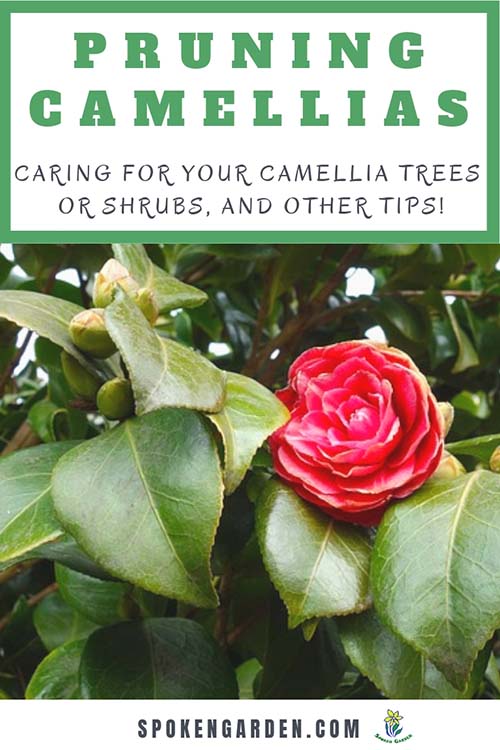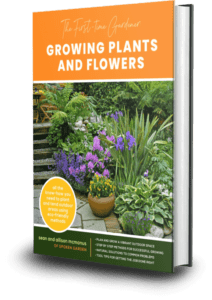Pruning your Camellia trees and shrubs takes time.
Most importantly, you need to have a goal in mind for your plant.
Overall shape? Plant size? Plant health?
Keep reading to find out how to start thinking about how to prune your Camellia plants and learn three different goals you can try in your own garden!
In this DIY Garden Minute Ep. 49 – “Camellia Pruning and Other Beneficial Care Tips,” we’ll teach you how to start thinking about your pruning goals for each plant with three different goals or scenarios AND then briefly go into how to do it along with types of cuts to make.
This episode is meant for any level of gardener who wants to learn more about the Camellia plant and helpful tips on how to care for and shape their plants.
Also, if you want to learn more about Camellia plant care in general, including its characteristics, colors, maintenance, and history, read our Camellia: A Gardener’s Guide and Plant Profile.
Types of Plant Growth
Do you like more natural-looking or finely-shaped plants in your garden?
Is your attention drawn more to specific shapes in a landscape or a connecting flow between plants?
What we are describing here is the difference between a plant’s natural form (informal) of growth or a more manicured look (formal).
Think of the formal look when you see an English Garden or an “estate” garden where plants and beds are perfectly shaped in smooth forms. There are even Topiary Camellia plants.
When you see a garden with informal growth and shaping, this is considered a more natural look and how the plant would look in its native habitat.
Keep reading to learn more in this episodes show notes.
Also, to learn more about pruning your Camellia plants with a slightly different approach, read this webpage from the American Camellia Society.
Camellia Pruning Episode Show Notes
Any pruning should follow Our 3 Pillars of Pruning, first. Listen to DIY Episode 10 to hear more!
Pruning your Camellia plant in three different ways depending on your goal for the plant:
- Goal #1: You want to either start or keep training your Camellia into an Informal (natural) growing tree.
- Goal #2: You want to either start or keep training your Camellia into an Informal (natural) growing shrub.
- Goal #3: You want to either start or keep training your Camellia into a Formal (unnatural or shaped) tree or shrub.
You can find other one-minute topics on our podcast page at spokengarden.com/podcast
On Instagram or Pinterest under @SpokenGarden (all one word) to follow or leave us a comment.
Find us on your favorite podcast platform and Alexa through MyPod or AnyPod!
See ya in the Garden!
And hey—before you head out—if you want to connect with us and subscribe to our newsletter go to Spoken Garden’s free resource page!
We have FREE garden content we are so excited to give to you, like cheat sheets, plant profile sheets, etc! See you there!
Thanks for Listening!!!
Share Your Thoughts:
- Leave a note in the comment section below.
- Leave comments/ suggestions at Seanandallison@eseospace.dev
- Share our show on Twitter, Facebook, or Pinterest.
To Help Out The Show:
- Leave a review on iTunes. Your ratings and reviews really help us out!
- Subscribe on iTunes or Spotify.

Click the graphic above to save “Camellia Pruning” to Pinterest for later!
*Spoken Garden is a participant in the Amazon Services LLC Associates Program, an affiliate advertising program designed to provide a means for sites to earn advertising fees by advertising and linking to Amazon.com.
Subscribe on iTunes
Today’s Topic:
Camellia Pruning and Other Beneficial Care Tips!
Learn about pruning your Camellia plant in a nutshell with these 3-goals in mind!
Downloads:
“Prune Like a Pro” Cheat Sheet
What You’ll Learn:
- 3 different ways to prune your Camellia shrub or tree based on your pruning goals.
- How to apply thinning and heading cuts to shape your Camellia shrub or tree.
- What the difference between formal (shaped) versus informal (natural) pruning.
Resources:
Some of the resources and products below may be affiliate links, meaning we might get paid a commission (at no extra cost to you) if you use that link to make a purchase.
- Camellia: A Gardener’s Guide and Plant Profile
- The Camellia Flower and Its 6 Delightful Shapes: DIY Garden Minute Ep. 47
- Best Pruning Shears For Any Gardener!
- DIY Garden Minute Ep. 30: Understanding Basic Plant Growth
Other Gardening Products Related To This Podcast You Might Not Have:
- Best pruning shears
- Loppers
- Hand saw:
folding or fixed
- Blower
: hand-held or backpack, gas or electric
- Leaf Rake
: metal or plastic
- Hard Rake
: metal


